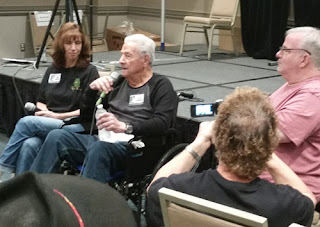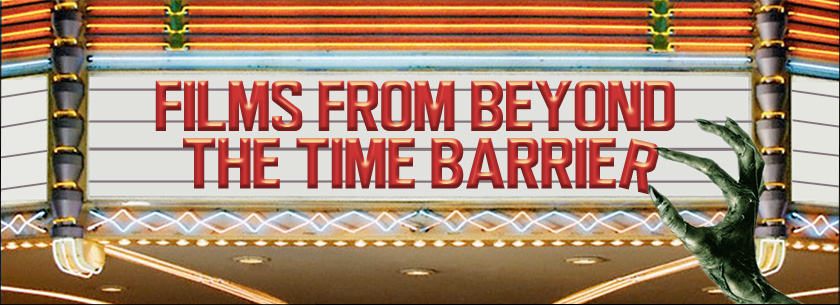The comic artist “gods” Bernie Wrightson (Swamp Thing) and Jim Steranko (Nick Fury) were guests of honor. I was heavily into comics and science fiction at the time (even editing a short-lived fanzine), but I was most impressed with the movies they screened at the con. I remember being blown away by Hammer’s Five Million Years to Earth (aka Quatermass and the Pit, 1967) and Karel Zeman’s wonderful, visually striking fantasy film The Fabulous Baron Munchausen (1962; sadly, almost completely forgotten today). [Editor's note: as of Feb. 2020, The Fabulous Baron is available in a beautiful three film set from Criterion, Three Fantastic Journeys by Karel Zeman.]
This was a watershed moment for me, as I would gradually wander away from comics and literary science fiction to renew a deep and abiding love of movies. I was the prototypical monster kid of the 1960s, watching every creature feature I could possibly dial in on the old black and white TV, and worshipping at the Church of the Universal Monster.
The ‘70s was a time for discovering Hammer’s glorious reenvisionings of the classic monsters, and of course, falling in love (as only a nerdy young fan can) with the likes of Caroline Munro, Veronica Carlson, and Martine Beswick.
Speaking of Hammer’s scream queens, I was intrigued by this year’s program at Creepy Classics’ Monster Bash (Mars, PA, June 21 - 23, 2019). I had seen ads for the conference in Filmfax over the years, and its focus on classic horror and sci-fi, along with fascinating guests of honor (e.g., Julie Adams of Creature from the Black Lagoon fame, who passed away last year), had me itching to attend. But geography and life’s usual busyness prevented me from making plans -- until now.
This year’s Bash brought together two famous Hammer actresses, Veronica Carlson (Dracula Has Risen From the Grave, Frankenstein Must Be Destroyed) and Martine Beswick (One Million Years B.C., Dr. Jekyll and Sister Hyde), along with Dracula A.D. 1972 alum Christopher Neame to the U.S. premiere of low-budget auteur Joshua Kennedy’s Hammer homage House of the Gorgon (2019).
Kennedy, who started making feature-length films in his teens, has been friends with all three and managed with luck and pluck to get them (along with Caroline Munro, who unfortunately was unable to attend) to appear in the film.
 |
| The still glamorous Veronica Carlson at her Q&A. |
House features not one but two Gorgon sisters, played with zest and sly humor by Munro and Beswick. Carlson, looking years younger than her age, plays the mother of a young woman (Georgina Dugdale) engaged to be married to the eccentric master of the house (Kennedy). Christopher Neame is also very effective as the glum, frightened village priest -- a character type that appeared numerous times in Hammer films.
While the digital photography and the variable acting among the less experienced cast members somewhat betray the film’s very low budget, it’s hard not to like such a meticulously and lovingly crafted tribute.
 |
| Martine Beswick receives flowers and applause. |
Other horror film references, some subtle and some not-so-subtle, range from the paintings of past nefarious movie characters lining the mansion’s staircase, to the bust of veteran Hammer character actor Michael Ripper that turns up in the local tavern.
Aside from being a great tribute, the story holds up pretty well on its own. Kennedy also has a definite talent for setting up and lighting a very effective, atmospheric scene. One in particular, where the victim, taking a bath, sees her attacker upside down from her perspective and imbued with an otherworldly light, delivers an authentic shudder.
House of the Gorgon received a thunderous ovation from the appreciative audience, and I was rooted to the spot, almost as if I had been turned to stone, at the sight of the three Hammer legends on stage with their 20-something director.
Other Monster Bash Highlights:
In her Q&A, Beverly Washburn, veteran of innumerable films and TV shows (Star Trek OS, Boris Karloff’s Thriller, and cult favorite Spider Baby among them), talked about her experiences on the set of Spider Baby. She described Lon Chaney Jr. as a darling. It was well known by that time that he was an alcoholic, but his drinking never affected the production. She confirmed that his tears during the famous soliloquy were real and heart-felt.
 |
| Beverly Washburn with conference organizer Ron Adams. |
Author Frank Dello Stritto gave a very funny and engaging talk on the history of Universal’s last great monster, the Creature from the Black Lagoon. Frank is the author of a new novel, Carl Denham’s Giant Monsters, which picks up on the monster hunter’s life after the events of King Kong. Riffing on that theme and with tongue firmly in cheek, he expounded on what happened to various characters from the Creature movies after their encounters with the Gillman, using stills from the actors’ subsequent films.
Film historian Greg Mank, author of the new biography Laird Cregar: A Hollywood Tragedy, gave a very moving talk on the hugely talented and haunted actor who almost literally was killed by type-casting and mistreatment by his studio. A respected veteran of mostly costume dramas, in 1944 Cregar became notorious for his effective and menacing role as Jack the Ripper in The Lodger. Unfortunately, it immediately became evident that the studio would henceforth typecast him in Gothic monster roles. Cregar was a very large man, and in his desperation to slim down to a more “matinee idol” appearance, he went on a crash diet that eventually led to a heart attack and death at a very young age. Mank also told a fascinating story of he and his wife years ago trying to find Cregar’s grave at Hollywood’s Forest Lawn cemetery, with a series of misadventures leading them to half-believe Cregar’s spirit was playing tricks on them.
At 89 years of age, Ricou Browning is the last living classic Universal monster, having portrayed the Gillman in the underwater scenes in all three Creature movies. In his Q&A he addressed the recent controversy over a new book, The Lady from the Black Lagoon: Hollywood Monsters and the Lost Legacy of Milicent Patrick, which asserts that Patrick was instrumental in creating the Creature costume, but was shunted aside and not given credit by Hollywood’s male patriarchy. Ricou asserted that during production of the first Creature film, he only saw Patrick twice, and only briefly each time. She appeared and watched for a short time while he was being fitted for the suit in Hollywood. Then on location, she put some finishing touches on the suit before Browning got in the water. Jack Kevan and Chris Mueller have been traditionally cited as the designers of the Creature suit.
 |
| Ricou Browning at the Q&A with his daughter (left) and author Tom Weaver (far right). |
For more information on future Monster Bashes and related events, see the conference news page.













